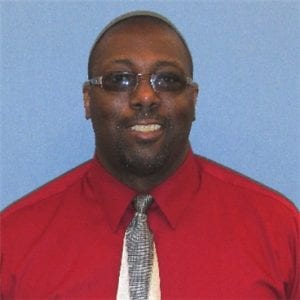 This summer, the Operational Excellence website is featuring a series of staff spotlights: stories about staff members who’ve taken on new leadership roles since the implementation of OE2C and are helping bring more innovation and efficiency to campus operations. Read more SMU staff spotlights
This summer, the Operational Excellence website is featuring a series of staff spotlights: stories about staff members who’ve taken on new leadership roles since the implementation of OE2C and are helping bring more innovation and efficiency to campus operations. Read more SMU staff spotlights
Few departments at SMU have undergone more change in the past eight years than Facilities. Eric English’s career reflects that change.
English started working at SMU in 1996 as a painter. He was promoted to facilities building inspector in 2003 and then, in 2006, became environmental services manager, overseeing the custodial and sustainability departments. In 2010, a large portion of Facilities was outsourced to Aramark, and he became Aramark’s operational excellence and sustainability manager. Eighteen months later, he left to take a position as the building and grounds manager at Parkland Hospital. After five years away, he returned to SMU’s Facilities Department in April to become director of maintenance and grounds.
It’s a big job, encompassing landscaping, pools and fountains, fleet management, office moves, trash and recycling collection, sports turf, plumbing, electrical, carpentry, locksmiths, building maintenance repairs and more. English oversees more than 50 managers, supervisors and staff members as well as outsourced custodial and landscape personnel.
Four months into his new role, English says he has noticed a positive transformation in Facilities’ business model. “How we did business in the past is certainly different from how we do it today,” he says. “We are much more focused on customers – students, faculty and staff – to make sure they have the best possible educational/work environment.”
One significant change that English and his team have implemented in the past several months is expansion of maintenance coverage. “Whereas before we had two people who worked weekdays only, we now have four people and shifts that handle weekends as well,” he says. “We can now provide coverage seven days a week, from 7 a.m. to midnight every day. We can respond to most emergency requests much faster because staff is now on site instead of having to be called to come to campus. That’s particularly important for calls regarding leaks and flooding, which are actually our most common emergencies.”
English says one of the chief advantages of the new structure is the leadership. “I have great leaders to lean on, along with fellow peers,” he says.
With leadership support, English says he and his team are working to make improvements in a number of areas. “For example, we are focusing on reducing the number of call-backs, making sure the work is done right the first time,” he says. “We are also responding to work orders more quickly, and making sure we have clear communication with our customers so they understand the status of their work requests.”
The biggest challenge, he says, has been changing the mindset and culture of how tasks should be performed. “It is difficult to get people to change, especially when they have been doing things a certain way for a long time. However, I am encouraged with the way we are moving toward being more proactive and more productive.”
As an example, he says, his department is creating a strong preventive maintenance program. “We will be able to extend the life of equipment and reduce repair calls by setting up regularly scheduled maintenance checks on a variety of items,” he says. “It’s like taking your car in for scheduled service – do that and your car will run more efficiently and have fewer problems.”
As his department continues to evolve, English says he is setting a number of goals for himself and his team. “My immediate goals range from building a strong recycling program and improving our floor care program to teaching staff to be good stewards of University funds (which will allow us to reduce costs), streamlining processes and developing training programs for staff. All of these things will take time, but we are focused on making steady progress to keep improving our service.”
And he is happy to be at SMU once again. “I love the SMU community and the people here – it’s what brought me back,” he says. “SMU has a real family atmosphere. It’s why people stay so long, and, like me, want to return!”

